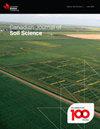覆盖作物和秋耕终止对非生长期土壤氮氧化物排放的影响
IF 1.5
4区 农林科学
Q4 SOIL SCIENCE
引用次数: 0
摘要
农田土壤是全球一氧化二氮(N2O)排放的主要驱动因素。在寒冷气候下,由于冻融循环期间的高通量,非生长期(NGS)排放可能非常显著。覆盖作物可以改变控制N2O产生微生物过程的关键土壤条件,在FT周期中有多种潜在途径增加或减少N2O的产生。在秋季种植覆盖作物可能会进一步破坏这些过程和覆盖作物对N2O排放的总体影响。然而,很少有研究涉及终止覆盖作物的做法如何影响NGS上的FT排放。利用通量梯度法连续测量常规玉米-大豆轮作N2O排放,研究了夏季建立覆盖作物(多年生黑麦草和深红色三叶草)(覆盖作物:+CC;无覆盖作物:-CC),因秋季种植而终止(有秋季种植:+FC;没有秋季栽培:-FC)在六个月的NGS中,其特征是几个冻结和解冻期。深红色三叶草覆盖作物完全冬季死亡,而黑麦草在+CC-FC田间存活。NGS总排放量(11 - 4月)在395.1 (-CC-FC)和978.1 (+CC+FC) g N2O-N ha-1之间变化了近2.5倍。与对照处理(-CC-FC)相比,单独秋耕(-CC+FC)和单独覆盖作物(+CC-FC)增加了NGS N2O总排放量,覆盖作物(+CC+FC)的秋耕增加了N2O通量。谨慎的CC物种选择和管理对于避免NGS排放的增加至关重要。本文章由计算机程序翻译,如有差异,请以英文原文为准。
Non-growing season soil nitrous oxide emissions as influenced by cover crops and fall tillage termination
Cropland soil is a major driver of global nitrous oxide (N2O) emissions. In cold climates, non-growing season (NGS) emissions can be significant due to high fluxes during freeze-thaw (FT) cycles. Cover crops can alter key soil conditions that govern N2O-producing microbial processes, with multiple potential pathways to either increase or decrease N2O production during FT cycles. Cultivating cover crops in the fall to terminate may further disrupt these processes and the overall impact of cover crops on N2O emissions. Yet, few studies have touched on how termination practices of cover crops impact FT emissions over the NGS. Using the flux gradient method to continuously measure N2O emissions from a conventional corn-soybean rotation, we investigated the effects of summer-established cover crops (perennial ryegrass and crimson clover) (with cover crops: +CC; without cover crops: -CC) when terminated by fall cultivation (with fall cultivation: +FC; without fall cultivation: -FC) over a six-month NGS that was characterized by several freezing and thawing periods. Crimson clover cover crop was completely winter killed, while the ryegrass survived on the +CC-FC field. Total NGS (Nov-April) emissions varied nearly 2.5-fold among treatments from 395.1 (-CC-FC) to 978.1 (+CC+FC) g N2O-N ha-1. Compared to the control treatment (-CC-FC), fall cultivation alone (-CC+FC) and cover crops alone (+CC-FC) increased total NGS N2O emissions and fall cultivation with cover crops (+CC+FC) increased N2O fluxes even more. Careful CC species selection and management are important to avoid elevated NGS emissions.
求助全文
通过发布文献求助,成功后即可免费获取论文全文。
去求助
来源期刊

Canadian Journal of Soil Science
农林科学-土壤科学
CiteScore
2.90
自引率
11.80%
发文量
73
审稿时长
6.0 months
期刊介绍:
The Canadian Journal of Soil Science is an international peer-reviewed journal published in cooperation with the Canadian Society of Soil Science. The journal publishes original research on the use, management, structure and development of soils and draws from the disciplines of soil science, agrometeorology, ecology, agricultural engineering, environmental science, hydrology, forestry, geology, geography and climatology. Research is published in a number of topic sections including: agrometeorology; ecology, biological processes and plant interactions; composition and chemical processes; physical processes and interfaces; genesis, landscape processes and relationships; contamination and environmental stewardship; and management for agricultural, forestry and urban uses.
 求助内容:
求助内容: 应助结果提醒方式:
应助结果提醒方式:


